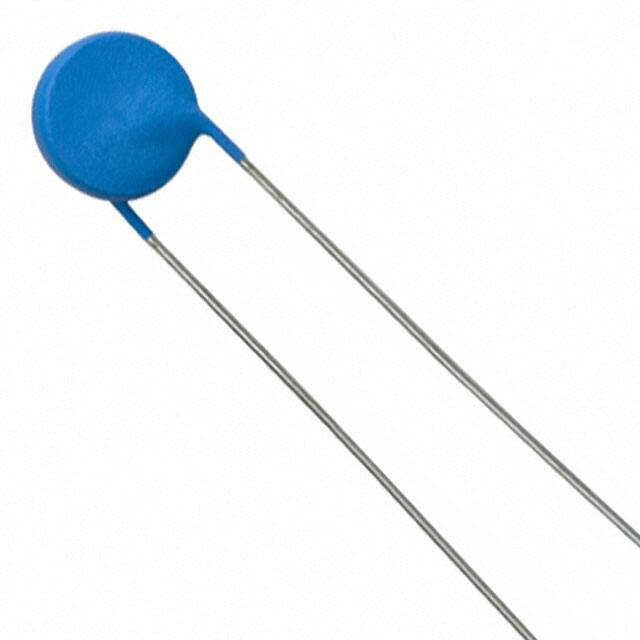NTC Thermistors - Disc and Chip Style
Temperature Measurement and Control Thermistors
DISC and CHIP Style
DISC & CHIP NTC
STYLE NTC THERMISTOR
Features
•
Wide Ohmic Value Range
•
Accurate & Stable
•
Fast Thermal
Response Time
•
Tight Tolerances
•
High Sensitivity
NTC Thermistors
�Negative Temperature Coefficient (NTC) thermistors are thermally sensitive
semiconductor resistors which exhibit a decrease in resistance as absolute temperature
increases. Change in the resistance of NTC thermistor can be brought about either by a
change in the ambient temperature or internally by self-heating resulting from current
flowing through the device. Most of the practical applications of NTC thermistors are
based on these material characteristics.
NTC Disc and Chip Style Devices
Ametherm manufactures Disc and Chip style thermistors in resistance values ranging
from 1.0 ohm to 500,000 ohms. These devices are suitable for a range of resistance
values and temperature coefficients from relatively low resistance and temperature
coefficients to very high values. Precision resistance tolerances are available to 1%.
Standard resistance tolerances are from 5% to 20%. All tolerances are specified at
25°C or may be specified at any temperature within the operating temperature range of
the thermistor.
Thermistor Terminology for Temperature Measurement & Control
Devices
•
•
•
The dissipation constant (D.C.) is the ratio, normally expressed in milliwatts per
degree C (mw/°C), at a specified ambient temperature, of a change in power
dissipated in a thermistor to the resultant change in body temperature.
The thermal time constant (T.C.) is the time required for a thermistor to change
63.2% of the total difference between its initial and final body temperature when
subjected to a step function change in temperature under zero-power conditions and
is normally expressed in seconds (S).
Alpha ( ) or Temperature Coefficient or Resistance is the temperature coefficient
of resistance is the ratio at a specified temperature, T, of the rate of change of zeropower resistance with temperature to the zero-power resistance of the thermistor.
The temperature coefficient is commonly expressed in percent per degree C (%/°C).
NTC DISC & CHIP
Selection
Considerations
•
Select Req'd. Resistance Value & Temperature Coefficient
�•
•
•
•
Determine Accuracy Req'd.
Review Power Dissipation
Determine Operating Temperature Range
Review Thermal Time Constant
Thermistor Applications
Time and temperature are two of the most frequently measured variables. There are
numerous ways of the measuring temperature electronically, most commonly by
thermocouples and negative temperature coefficient (NTC) thermistors. For
general purpose temperature measurement, NTC temperature sensors can operate
over a wide temperature range (-55 to +300°C). They are stable throughout a long
lifetime, and are small and comparatively inexpensive. Typically, they have negative
temperature coefficients between -3.3 and -4.9%/°C at 25°C. This is more than ten (10)
times the sensitivity of a platinum resistance thermometer of the same nominal
resistance. Ametherm's Disc & Chip style thermistors are used in many applications that
require a high degree of accuracy and reliability.
Some of the most popular applications of NTC thermistors include:
•
•
•
•
Temperature Compensation
Temperature Measurement & Control
Fan Motor Control
Fluid Level & Temperature Sensors
NTC DISC & CHIP - Selection Process
•
•
•
•
•
Select R Value
Determine R @ T
Calculate DEV for R @ T
Evaluate Power Rating (D.C.)
Review T.C. Requirements
Selection considerations for NTC Disc and Chip Devices
Power dissipation is a common problem in the use of thermistors as they can only
dissipate a certain amount of power.
•
If the power dissipated exceeds the dissipation constant (D.C.) rating of the
sensor it is likely that it will exhibit self heating.
��1DA101K-EC 100
A
0.1 0.06 3
10 28
0.07
1DA131J
130
A
0.1 0.06 3
10 28
0.07
1DA131K
130
A
0.1 0.06 3
10 28
0.07
1DA500J
50
A
0.1 0.03 3
6
28
0.07
1DA500K
50
A
0.1 0.03 3
6
28
0.07
1DB102J
1,000
B
0.1 0.06 3
10 28
0.07
1DB102K
1,000
B
0.1 0.06 3
10 28
0.07
1DB102K-EC 1,000
B
0.1 0.06 3
10 28
0.07
1DB501K
500
B
0.1 0.03 3
6
28
0.07
1DC103J
10,000
C
0.1 0.03 3
6
28
0.07
1DC103J-EC 10,000
C
0.1 0.08 4
12 28
0.07
1DC302J
3,000
C
0.1 0.08 4
12 28
0.07
1DC502J
5,000
C
0.1 0.08 4
12 28
0.07
1DC502J-EC 5,000
C
0.1 0.08 4
12 28
0.07
1DE104J
100,000
E
0.1 0.95 3
9
28
0.07
1DE104K
100,000
E
0.1 0.95 3
9
28
0.07
1DE104K-EC 10,000
E
0.1 0.95 3
9
28
0.07
2DA200J
20
A
0.2 0.05 7
20 24
0.1
2DA200K
20
A
0.2 0.05 7
20 24
0.1
2DA503J
50,000
A
0.2 0.05 7
20 24
0.1
�2DB101K
100
B
0.2 0.025 7
18 24
0.1
2DB102J
1,000
B
0.2 0.025 7
18 24
0.1
2DB102J-EC 1,000
B
0.2 0.025 7
18 24
0.1
2DB102K
1,000
B
0.2 0.025 7
18 24
0.1
2DB151J
150
B
0.2 0.025 7
18 24
0.1
2DB151K
150
B
0.2 0.035 7
19 24
0.1
2DC102K
1,000
C
0.2 0.035 7
18 24
0.1
2DC302J
3,000
C
0.2 0.1
7
30 24
0.1
2DC302K
3,000
C
0.2 0.1
7
30 24
0.1
2DE103J
1,0000
E
0.2 0.04 7
17 24
0.1
2DE103K
1,0000
E
0.2 0.04 7
17 24
0.1
2DE503K
5,0000
E
0.2 0.04 7
17 24
0.1
3DA100J
10
A
0.3 0.06 8
48 24
0.1
3DA100K
10
A
0.3 0.06 8
48 24
0.1
3DB500J
50
B
0.3 0.025 8
35 24
0.1
3DB500K
50
B
0.3 0.025 8
35 24
0.1
3DE502J
5,000
E
0.3 0.025 8
35 24
0.1
3DE502K
5,000
E
0.3 0.025 8
35 24
0.1
© 1998 -2013 Ametherm, Inc
�
很抱歉,暂时无法提供与“1DA101J-EC”相匹配的价格&库存,您可以联系我们找货
免费人工找货